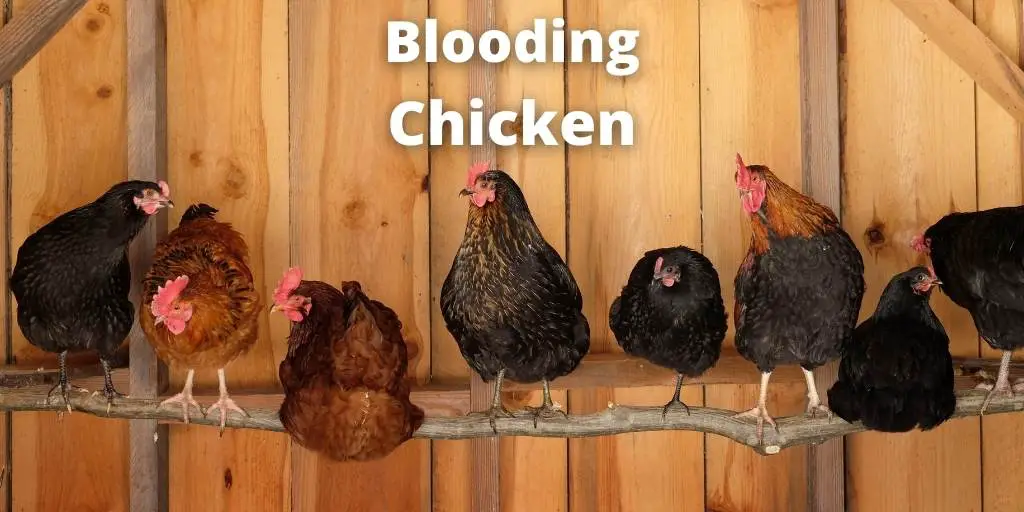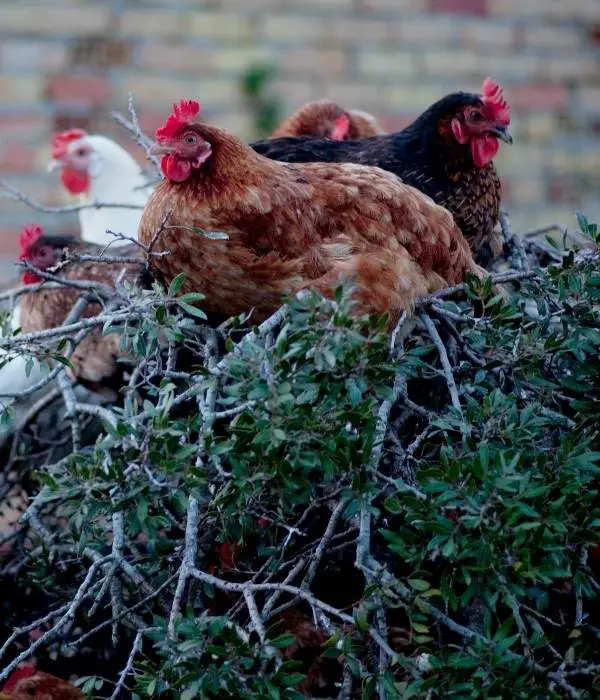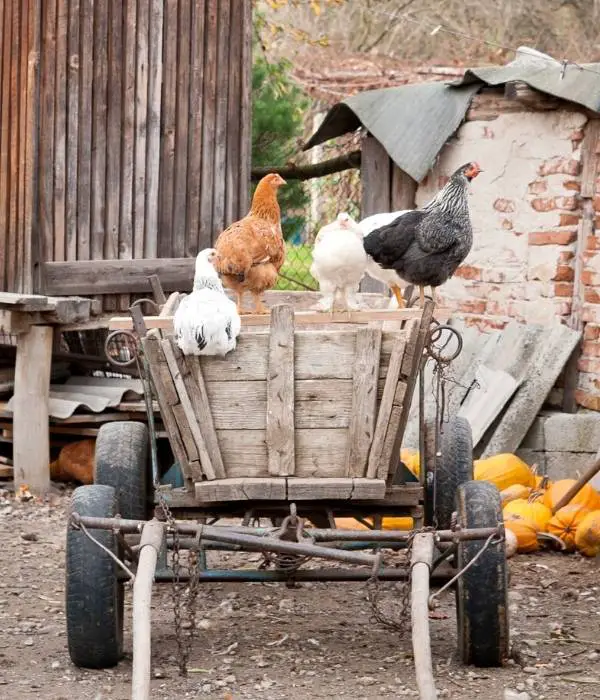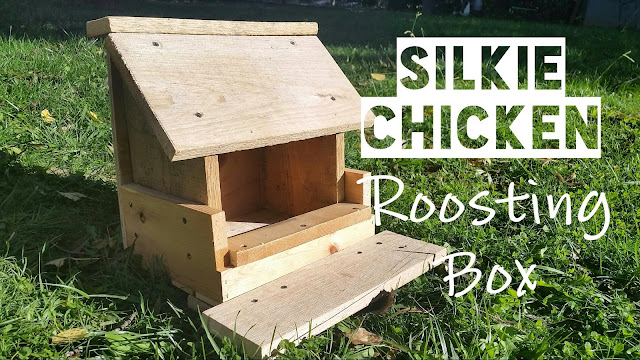
Chicken roosting is a very essential part of poultry. In this guide we have explained meaning, types, benefits, needs, DIY ideas, and FAQs about chicken roosting.
What is Chicken Roosting?
Chickens are prey animals. Roosting is where they sit in trees at night to be safe from predators. They also roost on daytime. Chicken roosting behaviors show that your hen thinks of you as a member of her flock or pack.
If she is comfortable with you, she may turn her backside to you and lift one leg while she is sitting on the roosting bar in your coop at night.
If she trusts you while lifting one leg and turning her backside to you, she might also pull one wing down and around so that it is somewhat protecting her body.
This behavior is essential for a hen who has chicks under her. Roosting is normal and natural behavior for chickens and other birds.

Chicken roosting behaviors can also be seen when your hens are laying their eggs. Once the egg is released from her vent, she will turn around and sit on it to help push it out of her body, or if the roost has enough space, she might get up and turn completely around and sit on the eggs.
Once she is done sitting on her eggs, she will probably get up and relace her nest in preparation for another egg if you haven’t gathered them already.
Also read: Hen Vs Rooster: Know the real difference
Types of Chicken Coop Roosting Ideas & Space
Chicken Roosting Bars
Chicken roosting bars are one of the best ideas to provide chickens with a place to sleep. You can purchase roosting bars or build your own, but the bars must be sturdy and large enough for your chickens to rest comfortably.
One chicken needs about eight inches of space, so use that as a guide when you’re building roosting bars.
Regular coop perches are horizontal bars with a few inches of space in between. These are fine for chickens who will not roost, but if your chickens can and will roost, you’ll need something sturdier than coop perches.
Chicken Roosting Ladders
Chicken roosting ladders are an essential part of your coop, not just for comfort but also to prevent injury.
If chickens are forced to sleep on the floor, they will scratch about during the night and risk getting bumblefoot or even picking up parasites that can damage your flock.
It’s important to provide space for all of your birds to have a comfortable sleeping spot so that they can rest and stay healthy. So, we can say it is one of the best chicken roosting ideas.
Chicken Roosting Boxes
Roosting boxes are an everyday staple in most modern chicken coops, and it is the roost that the chickens perch on to sleep at night.
The roost can be made out of many different materials such as wood, metal, plastic, or anything you choose to use.
There are two main types of roosts, fixed and moveable: Fixed roosts are fixed permanently to the rest of the coop, while moveable ones can be taken out and replaced as needed.
It is also possible to have a fixed section on the side of the chicken coop that allows you to place your moveable roost there when it is not being used.
Chicken Roosting Standard Perches
Chicken roosting standard perches vary depending on the size of the fowl and its family status. Roosting is when a chicken sleeps at night with one or more other chickens on a wooden perch, an old chair, or anything else that will support its weight.
There are several standard roosting requirements in most coop building guides for healthy chicks and grown birds alike.
The average standard perch-space requirements are 6 inches for bantams, 8 inches for small fowl, 10 inches for medium-sized fowl, and 12 inches for larger breeds.
These measurements should never be decreased to less than recommended minimums. The more space a chicken has in its coop, the better it will feel to be home!
A rule of thumb for determining if your chickens are overcrowded in their coop is to look at the personal space per bird. This should be about 6 inches per bird, including egg-layers and meat chickens.
Chickens will need more space in a heated coop during the winter months. It is okay to have a larger coop and run area than required, as long as it still meets the minimum standards outlined in your particular coop building guide.
Benefits and Needs of Chicken Roosting Perches

1. Natural Behavior
Roosting perches allow chickens to engage in their natural behavior, sleeping at night. Therefore, they need a good quality roosting perch when they are chicks to continue this habit for life.
2. Going to Sleep
Chickens use the roosting perches as a cue to go to sleep, just the way that people have a bedtime.
3. Resting up for Their Day
Chickens are most active when they wake up, so having a good night’s sleep at night ensures they are well rested for food production and egg-laying in the morning.
4. Comfort
The chickens will be comfortable when roosting and resting, making them more likely to lay eggs in the morning and be active in food searching and pecking.
5. Better Health
Chickens who are tired and not rested suffer from worse feather conditions and skin problems, and worse overall health.
Also read: Complete information about chicken molting
6. Feather Condition
Having a perch is beneficial for their feather condition, protecting them from the elements and making them look more beautiful.
7. Safety
The perches should be safe for chickens to use at night, so they should not be too high or low off the ground, the surface needs to be vital to support their weight, and it should not break easily if they land on it.
Also read: Best electric fencing for chicken coop and run
8. Good Behavior
The chickens should not be kept off the perches; otherwise, they might engage in bad habits such as picking each other.
9. Pointless Use of the Food
Chickens need a safe and comfortable place to sleep, so it is a pointless use of their food store if they don’t have a good quality roosting perch.
10. More Eggs
The chickens will lay more eggs as they feel genetically predisposed to do so since roosting and resting/sleeping is natural for them.
Roosting perches protect the chickens from destructive behaviors such as feather picking, cannibalism, and possible death from flying off a high place.
How to Build a Chicken Roost? Know the Shape, Size, Placement, & DIY Ideas for Roosting Space
It has been proven that chickens have good sleeping habits if they can roost at night. Chickens will often lay their eggs in a nesting box.
By building a roosting bar, your chickens have the option to sleep off of the floor and have a more comfortable place to rest at night.
DIY Chicken Coop Roosting Bar
DIY Chicken Coop Roosting Bar Materials
- 2 x 4 x 8 piece of lumber (length depends on how big you want the roosting bar to be)
- Chain (length depends on whether or not you want it to hang from anything, I recommend about 6 inches for a little bit of leeway)
- 2 hinges
- Screws that match your hinges
DIY Chicken Coop Roosting Bar steps
- Cut the 2 x 4 you have chosen to be your roosting bar down to a length of 18 inches. This is for one side.
- Measure and mark a spot on the wood about 8 1/2 – 9 inches from the edge of the board, which will be where you want your first perch to go.
- Cut out a section of the board about 1/4 inch wide and big enough to fit your chain into.
- Drill two holes on either side of where you just cut (the outside edge). The holes should be 3 inches apart.
- Cut the chain down to size with wire cutters (I would make it about 6 inches long).
- Insert one end of the chain into the hole on one side of your board and screw in a small nail to hold it in place (if you want to hang your bar, skip this step)
- Screw-in two hinges onto the edge of the wood that is opposite where just screwed-in nails are at.
- Attach the chain to your newly installed hinges with a small nail.
- When you are satisfied with how it looks, paint said bar in color of choice or until the desired look is achieved.
- You can add decoration to your DIY chicken coop roosting bar if you want, but it isn’t necessary.
DIY Chicken Coop Roosting Ladder
You’ll need the following:
- 1’x2′ wooden boards (how many depends on how long you want your ladder)
- Wood Glue
- Hammer/Nails/Screws
- Four nails or screw hooks, 6 ft. of 1×3 for the rungs. Two ft. of 1×2 for the rung holders.
DIY steps for making roosting ladders
- First, cut the boards to the desired length (have longer ones in mind than you think you’ll need). I found it easier to play with the ladder after making each rung before cutting all of them because if something didn’t fit well, I could quickly fix it.
- Next, use your wood glue to attach the rung holders to the 1×2 boards. If you’re using something that isn’t wood glue, then use nails or drill holes for screws.
- After the glue is dried/screws are in place, attach each rung holder to a board with either nails or screws (again, I don’t think wood glue would be strong enough for this). I cut the excess off of the 1×3 to make it look nicer.
- Lastly, attach your 1×2 boards in a triangle shape at the top. I used three nails in each corner since that’s what was closest. If you’re using screws, then drill holes into all four corners.
DIY Standard Chicken Roosting Perch
Required Materials:
- PVC pipe (You may use other materials such as wood or bamboo if desired.)
- Saw
- Ruler
- Measuring tape
- Screwdriver (or any tool that can be used for screwing)
- Drill (if you plan to drill holes in the PVC pipe)
Optional Materials:
- Paint or Stain (I chose not to use this because I wanted it unfinished so I could easily paint/stain it a different color if needed)
- Nails, screws, clamps, etc. (For extra support)
Process:
- Cut the PVC pipe into appropriate lengths with the saw. I chose to make mine eight feet long each because it would reach any height within my coop. PVC pipes are cheap, so you don’t have to cut them precisely to size. This is another reason why I chose not to use paint or stain.
- Connect the PVC pipe to form a triangle with the screwdriver and drill, if necessary.
- Hang in your chicken coop and enjoy!
DIY Chicken Roosting Box

Materials needed:
- A large piece of wood with a cutout for your dimensions (see steps 1-4)
- 3 small boards per side, make sure they are thick enough to be sturdy but not too thick, or else it will be hard to cut out the chicken entrance (see steps 5-6)
- Chicken wire about 2 feet high; make sure it’s as thick as possible (see steps 11 to put chicken wire on the roosting box)
- Wood screws about 3 to 5 inches long, and a drill with a screwdriver bit (see step 12 for how we attached the chicken wire)
- A staple gun (optional, see step 13 to attach the chicken wire)
Tools needed:
- Table saw, or Miter saw (used in steps 1 and 5)
- Drill with screwdriver bit (used in step 12 to screw on top of the box). I used a cordless drill to make it easier
- Router (optional, see step 5)
- Jigsaw or other saw to cut out an entrance for chickens (used in steps 2 and 6)
- Tape measure, pencil, and straight edge or chalk line (used in steps 3 and 7)
Steps:
- Find the dimensions for your roosting box. We used (L) 24 inches, (W) 8 inches, and (H) 6-7 inches
- Cut out the entrance with a saw if necessary (we used a jigsaw to cut out the entrance).
- Measure out about an inch on each side of the wood board beside the cutout of the entrance area. Mark it with a pencil and straight edge (or use a chalk line).
- Use the router to carve in groves for roosts (optional)
- Optional: If you want to add extra support, take your third board and measure out an inch on each side of the wood; mark it with a pencil and ruler.
- Take your tape measure and mark off every 1/8 inch on each side of the board (so you will have eight marks), connect your marks to make a square; this is where you are going to drill the holes for the screws using a drill bit that is slightly smaller than the screw (see picture).
- Drill holes 1/8 into the board for eight screws, then drill matching bigger holes on wood that you use to attach chicken wire onto a roosting box (we used 1×2’s), we also drilled one hole in between each of these eight smaller holes so that it made a square and the chicken wire wouldn’t move around.
- Attach 3 of your small sideboards to the mainboard with the screws and drill; make sure they are opposite of each other, so you have a square structure.
- Cut out chicken wire using tin snips.
- Staple chicken wire to wood using a staple gun.
- Optional step: If you want to attach the chicken wire to the roosting box, use your drill with a screwdriver bit and screw the wood onto the 1×2’s connected to the mainboard.
- Attach a hook to each corner of your roosting box and hang it on the chicken wire
All done!
FAQs
Do My Chickens Need Chicken Coop Roosting Bars?

Chicken roosting bars are an additional piece of equipment in a chicken coop, which you may decide is necessary based on the location and size of your chicken run.
Roosting bars can either be attached to the wall inside the chicken run for chickens to sleep on overnight, or they can be built inside the chicken coop so that chickens can sleep there at night.
If you allow your chickens to roam free throughout the day, you will need to consider how they will return to their chicken coop each night. Providing roosting bars lets them an easy way back into their shelter before dark so that they can seek protection from predators.
When Do Chickens Need a Roosting Box?
A roosting box should be one of the first coop accessories or chicken housing you get for your hens. Roosting boxes are an efficient way to keep chickens off the ground, prevent injuries, and help with egg-laying problems.
Do Roosting Chicken Boxes Have to Be Indoors?

It is highly recommended that your chickens have access to an enclosed indoor or covered area for roosting.
This will shelter them from the elements and increase safety, especially during winter months when precipitation may block access to the outdoor enclosure.
What Is an Ideal Chicken Roosting Bar Height?
As chickens grow, they naturally become more independent, moving off their mother’s roosts to set up nests and find food. An ideas chicken roost must be 1.5 feet above the ground.
Summary
Chickens need roosting to sleep at night. Roosting poles are the best way to provide a safe place for your hens to rest and stay away from predators like cats and raccoons that might want an easy meal.
Chickens will naturally find a high spot to perch on; they’ll end up anywhere from trees to the bottom of water tanks.


Leave a Reply